
 |
Inboard Flatbottom
- current classes |
Jersey Speed Skiffs |
Crackerbox |
Super Stock |
Grand National |
Can Am |
Pro Stock |
K Racing Runabout |
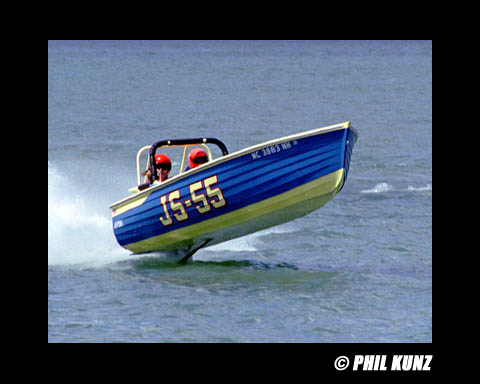 |
JS - class (Jersey Speed
Skiff)
This runabout class is required by special rules to fall within the limitations of minimum weight ready to run without fuel shall be 1,600 lbs. Boats must carry a crew of two. Hulls can be made out of either wood or fiberglass. Hulls must be exactly 16 feet long. The height from 28" in from the transom and bow most be 2' and the bottom width at transom must be either 41" (+or- 2") The only engines permitted are either the GM 283ci or the GM 305ci automotive or marine engine. The engine rules are very strict and take up more than 4 pages. This is mostly an East coast class. The current rules require that each boat must have a roll cage, and the passenger & driver must be harnessed in. This class started in the 1940's. |
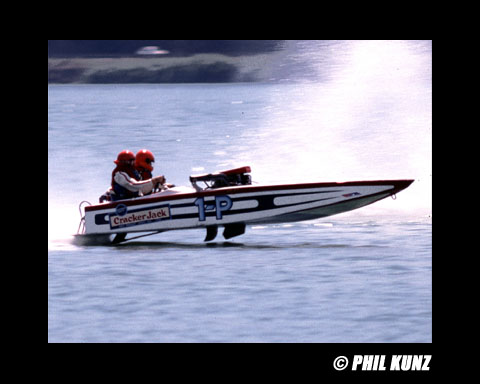 |
P - class (Crackerbox) Crackerbox Class The cockpit had to be behind the engine, with two seats (passenger & driver). Hulls must a minimum of 13'6" and no longer than 15'6." The minimum weight is 1,250 lb. including the complete boat, wet and ready to race. The motors have a maximum of 275 cubic inches, made of cast iron and built by a U.S. auto manufacturer for use in passenger cars and trucks. Aluminum heads may be used, but fuel supply limited to carburetors only. Fuel injection is not permitted. Crackerboxes do have an alternate 314 cubic inch motor with special rules for that engine. Boats must be raced with two persons on board. The Crackerbox run mainly on the West coast of the U.S. This class was started in the late 1940's. |
 |
SS - class (Super Stock)
The Super Stock Class began in 1970 as the stock version of the SK Class. They had to be a minimum of 16 ft long and 6 ft wide. The motor had to be out of an American V-8 passenger car that had a minimum production of 5,000 units. Other very strict engine rules were implemented for this class. Nineteen different U.S. auto engines from 327 cubic inches to 427 are acceptable for this class. Different motor specification rules apply to each of the different motors eligible. The drivers cockpit must be in front of the engine. This class was started in the 1960's. |
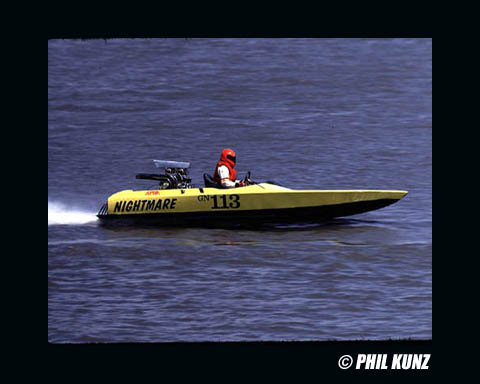 |
GN - class (Grand National
Runabout) Gran National Runabouts began in the mid 1970's as a mini marathon Flatbottom Class. They run heats that last 15 minutes no matter how many laps have been completed. Engines are 500 cubic inch and can be carb or fuel injected. No superchargers. The engine must be amidship with the driver in the front. This class runs minute heats instead of the typical 3-5 lap heats. |
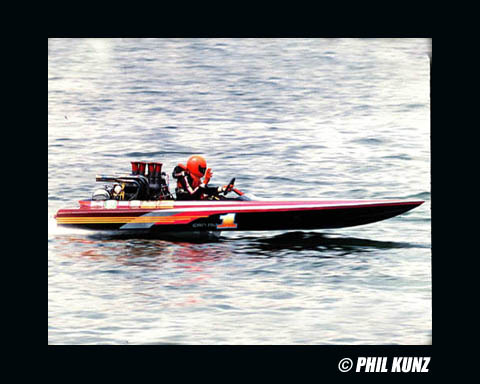 |
Can/Am - class
Can/Am Class is a Canadian American class similar to Pro Stock. |
 |
PS - class (Pro Stock) Pro Stock Class This class has special rules set up with and enforced by a special Flatbottom A.C.T.I.O.N. Board. The hulls must be a minimum of 16 feet long, and a maximum of 20 feet long with a minimum beam of 72 inches. The motors can be a maximum of 500 cubic inches with any carbs or fuel injection. Fuels restricted to pump, aviation, and methanol blends with additives permitted, except nitromethane and nitrous oxide. The A.C.T.I.O.N. board has many other special rules including the prize money percentage breakdowns. This class started in the 1950's as SK class. |
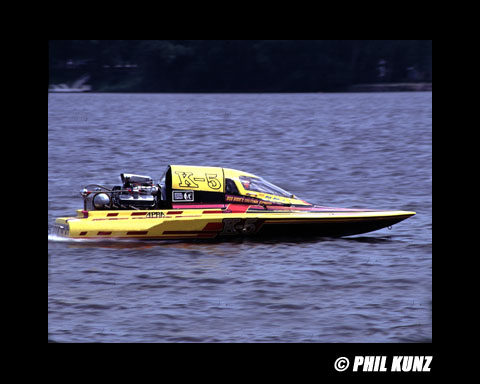 |
K - class (K Racing Runabout)
K Racing Runabout Class The Flatbottom A.C.T.I.O.N. Board, also governs the strict driver eligibility, hull shape, motors, superchargers, prize money, safety equipment, etc., in this highly modified class. The hulls minimum length is 17 feet with a maximum of 20 feet, except 21 feet is allowed with special hull measurement rules. This class was started in the 1970s. |
General rules concerning safety - It is mandatory
that all SS, PS, Comp Jet, and KRR boats competing with registered reinforced
cockpits, have solid flotation material filling the outer areas of both
sides of the hull. The SS, PS, KRR must also have the solid flotation
filling the bow area of the hull forward of the kickboard. Air pockets
(tire tubes, milk jugs, air tight compartments, etc.) are not considered
adequate flotation.
All current racers must be seat belted in, have separate air supply if in an enclosed capsule and must have a physical exam each year. No "wrap around" or "full face" helmets are permitted. Many special rules require that certain metals with certain alloys are the only ones that can be used on inboards. They must have certain shear strengths, endurance limits and yield points. © 2001 Phil Kunz |